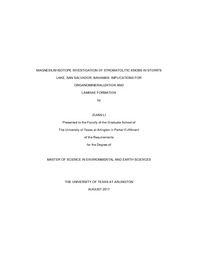
ATTENTION: The works hosted here are being migrated to a new repository that will consolidate resources, improve discoverability, and better show UTA's research impact on the global community. We will update authors as the migration progresses. Please see MavMatrix for more information.
Show simple item record
| dc.contributor.advisor | Griffith, Elizabeth M. | |
| dc.creator | Li, Zijian | |
| dc.date.accessioned | 2017-10-02T14:42:58Z | |
| dc.date.available | 2017-10-02T14:42:58Z | |
| dc.date.created | 2017-08 | |
| dc.date.issued | 2017-08-21 | |
| dc.date.submitted | August 2017 | |
| dc.identifier.uri | http://hdl.handle.net/10106/26985 | |
| dc.description.abstract | Storr’s Lake, a hypersaline lake located on San Salvador Island, Bahamas, contains modern, fine-grained stromatolites. This study focused on two morphological types of stromatolitic mounds in Storr’s Lake (pinnacle mound and plateau-mushroom) and systematically investigated their mineralogy, elemental abundance, carbon, oxygen and magnesium (Mg) isotopic signature to gain insights into the organomineralization process and laminae formation of stromatolites. In addition, the hydrochemistry of Storr’s Lake was characterized by in situ measurement of water parameters, elemental analysis, and Mg isotope investigation. Cations and anions analysis indicates the lake is spatially homogenous and shows little seasonal variation. Mg isotope analysis of the lake water suggests seawater is the primary Mg source to the Storr’s Lake and dominates the Mg isotopic budget of the lake.
X-ray diffraction studies showed that the surficial crusts of both types of stromatolites are enriched in high-Mg calcite and their interior zones are dominated by aragonite. The mineralogic distribution is consistent with the variations of Mg/Ca and Sr/Ca molar ratios of stromatolitic sublayers. The organominralization processes mediated by both photosynthetic and heterotrophic microbial metabolisms result in in situ micritic precipitation. The more negative δ13C signature of deeper sublayers suggests organomineralization processes continue at deeper horizons, whereas the relatively uniform and positive δ18O values are controlled by the evaporitic condition of the lake. An increase in the Mg/Ca molar ratio within microbial mats is assumed to be responsible for the hypothesized mineral phase transformation from initial high-Mg calcite to aragonite. The Mg isotopic composition (δ26Mg) of stromatolitic sublayers falls within the range of values previously reported for biogenic high-Mg calcite and aragonite, and displays strong dependence on mineral compositions. The difference between the ∆26Mgcarbonate-lake water values in this study from the ∆26Mgcarbonate-solution values of abiogenic precipitation experiments suggest vital effects on Mg isotope fractionation during organomineralization of high-Mg calcite but not aragonite. A mechanism for organomineralization and laminae formation is proposed by comparing stromatolites from Storr’s Lake and other environments (hypersaline, open marine, and freshwater), which may have crucial implications for interpreting the ancient stromatolites in the fossil record. | |
| dc.format.mimetype | application/pdf | |
| dc.language.iso | en_US | |
| dc.subject | Stromatolite | |
| dc.subject | Mineralogy | |
| dc.subject | Mg isotope | |
| dc.title | MAGNESIUM ISOTOPE INVESTIGATION OF STROMATOLITIC KNOBS IN STORR’S LAKE, SAN SALVADOR, BAHAMAS: IMPLICATIONS FOR ORGANOMINERALIZATION AND LAMINAE FORMATION | |
| dc.type | Thesis | |
| dc.degree.department | Earth and Environmental Sciences | |
| dc.degree.name | Master of Science in Earth and Environmental Science | |
| dc.date.updated | 2017-10-02T14:45:05Z | |
| thesis.degree.department | Earth and Environmental Sciences | |
| thesis.degree.grantor | The University of Texas at Arlington | |
| thesis.degree.level | Masters | |
| thesis.degree.name | Master of Science in Earth and Environmental Science | |
| dc.type.material | text | |
| dc.creator.orcid | 0000-0002-1583-2315 | |
Files in this item
- Name:
- LI-THESIS-2017.pdf
- Size:
- 20.55Mb
- Format:
- PDF
This item appears in the following Collection(s)
Show simple item record


